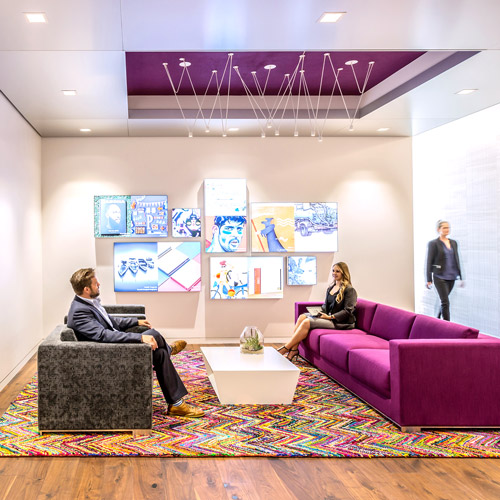
As a child, David Kepron painted passionately. Not long later, he found similar artistic fulfillment in architecture, especially forward-thinking modernist and deconstructivist styles. However, he can just as eagerly talk to you about fashion, merchandising, industrial design, theater, and trend analysis. And although it’s easy to focus on old habits and even grow distrustful of advanced technologies as you get older, Kepron has only become more engaged. To him, the smartphone has changed everything he once knew about design.
Luckily, Kepron landed at a company where innovation is key. As the vice president of global design strategies – distinctive premium brands at Marriott International, he’s been given the opportunity to stand at the forefront of hospitality design for six different Marriott brands. “The invitation to join Marriott wouldn’t have been nearly as exciting if the offer would have been to work on one single brand,” he says. “Working on six different brands all at once means that I’m putting on different hats all day long. I like thinking quickly, cycling through ideas, and finding multiple solutions to a problem.”
Kepron’s background in retail matches that peripatetic mind-set. In designing retail experiences, he routinely found himself working with a variety of brands and audiences. No matter the brand, however, Kepron’s work always aimed to foster an emotional connection between the consumers and his designs. His experience as a retail architect, he says, wouldn’t be as strong without a connection to visual merchandising and the ability to tell a story using a brand’s products, services, or sensibilities.
“I’m constantly putting myself in the shoes of the customer and asking, ‘What do I feel at this point? What am I feeling at this next part of the juncture? How am I transitioning through it, and what am I feeling from an emotional point of view and from a psychological point of view?’” he says.
Retail (r)Evolution
David Kepron’s Retail (r)Evolution is built on the evolving ideas of relationships in branding and design culture, using neuroscience as a lens. “I often say it’s not what you carry home in your shopping bag that matters, it’s what you carry home in your heart and mind that determines whether or not you adopt that brand into the family of brands that you weave into your lives,” Kepron says. The book was published in 2014 by ST Media Group International Inc.
Answering those questions has changed rapidly in recent years as technology alters the way we engage not just with products and brands but with each other. “We live in a different world now where the intimacy or the embodied nature of human relationships are being changed because of our propensity to find those engagements through digital connections,” Kepron says. That is true, he adds, not just in terms of social media and digital devices. “Rather, it’s how that device is fundamentally changing us culturally and the evolution of the expectations that a younger generation of shoppers are beginning to develop in terms of how customer experiences should unfold,” he says. “The retail world in general is woefully unprepared to deal with my 15-year-old.”
With Kepron’s help, Marriott International is working to articulate this evolution of expectations. In addition to refining concepts such as mobile check-in and keyless entry, they’re also toying with what impact augmented reality and virtual reality applications could have on a guest’s experience. He mentions the prospect of 3-D projection technology in hotel rooms and its ability to one day allow a guest greater aesthetic customization. In the future, Kepron says, the relationship between brands and guests will be much more collaborative than ever before.
In the meantime, he and his team are working to see how they can use these technologies to connect with guests earlier in the process. By example, he notes that placing a potential visitor in the hotel via virtual reality earlier in the process might better convince them to book a room.
“Using tools such as augmented and virtual reality aren’t just about showing people cool things at the end of the process,” he says. “Putting people in places much earlier helps them make better-educated decisions about what works and what doesn’t work. To do that, though, is to change the root of design thinking.”
That’s not the only way in which Kepron wants to alter the way we consider design. Another interest that he wants to weave into his work is an especially intriguing one: neuroscience. Kepron’s interest in the field developed from his college studies in psychology and interpersonal dynamics; he noticed that many of its core tenets could be applied to his interest of environment-impacted emotion in the retail space.
“As I began to look at that more, I began to really see how much of what goes on in the neurobiological level of our brain actually is the underpinning for experience,” he says. “We collectively share a few hundred million years of brain development, and our neurobiology and brain functions have coded into us common responses to our environment. These responses are felt in our bodies rather than being part of our conscious awareness.” If Marriott can understand what happens for a guest at a brain level, he says, the organization is better able to craft experiences that positively affect emotional connections to the brands.
In fact, Kepron wrote a book on the subject, Retail (r)Evolution, and is currently developing actionable ways to apply some of its theories. “I want to see if we can leverage those tools to get a better understanding of what guests are feeling when they’re on our properties,” he says. That process will entail more strategic, innovative tools than mere poststay surveys.
“It’s about getting people wired and standing in a virtual environment of a concept, Then, we can begin to understand what brain areas might be activated when they stand in a certain place,” Kepron says. “In addition to using digital tools to augment design processes, we need to understand that the world of digital immersion is fundamentally rewiring an emerging guest’s brain. Their digitally enabled lifestyle will shift expectations and how we need to communicate with them.”
Then, maybe, the industry will be prepared for the world’s 15-year-olds.
Photos: Issac Maiselman/Courtesy of Marriot, Courtesy of Marriott
“Guests expect the technology experience at a hotel to be at least as good as it is in their homes. This means that hoteliers looking to exceed expectations should aim for an even more advanced technological solution, thinking outside of the box. Legrand and Marriott are both leaders in this type of thinking, bringing this experience to life.”
Kenneth Freeman
Senior VP, Demand Creation
Legrand, North & Central America


